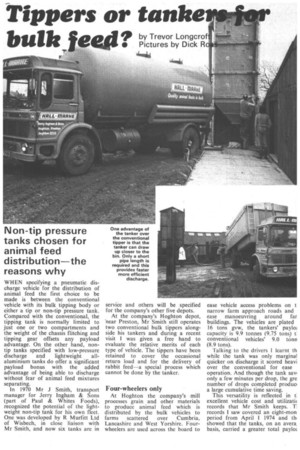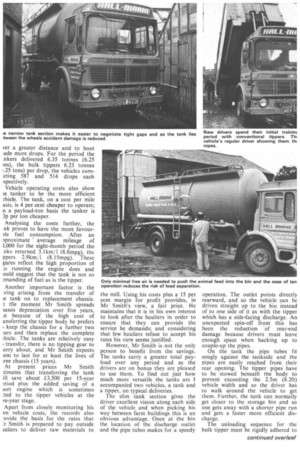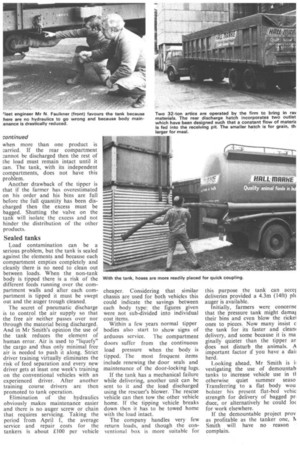Tippers or tan he
Page 36

Page 37

Page 38

If you've noticed an error in this article please click here to report it so we can fix it.
bulk• by Trevor
egg'
• Pictures by Dick R Longcrof
Non-tip pressure tanks chosen for animal feed distribution—the reasons why
WHEN specifying a pneumatic discharge vehicle for the distribution of animal feed the first choice to be made is between the conventional vehicle with its bulk tipping body or either a tip or non-tip pressure tank. Compared with the conventional, the tipping tank is normally limited to just one or two compartments and the weight of the chassis flitching and tipping gear offsets any payload advantage. On the other hand, nontip tanks specified with low-pressure discharge and lightweight allaluminium tanks do offer a significant payload bonus with the added advantage of being able to discharge without fear of animal feed mixtures separating.
In 1970 Mr J Smith, transport manager for Jerry Ingham & Sons (part of Paul & Whites Foods), recognized the potential of the lightweight non-tip tank for his own fleet. One was developed by R Murfitt Ltd of Wisbech, in close liaison with Mr Smith, and now six tanks are in service and others will be specified for the company's other five depots.
At the company's Hoghton depot, -near Preston, Mr Smith still operates two conventional bulk tippers alongside his tankers and during a recent visit I was given a free hand to evaluate the relative merits of each type of vehicle. The tippers have been retained to cover the occasional return load and for the delivery of rabbit feed—a special process which cannot be done by the tanker.
Four-wheelers only
At Hoghton the company's mill processes grain and other materials to produce animal feed which is distributed by the bulk vehicles to farms scattered over Cumbria, Lancashire and West Yorshire. Fourwheelers are used across the board to ease vehicle access problems on t narrow farm approach roads and ease manoeuvring around far buildings. The vehicles are plated 16 tons gvw, the tankers' paylo capacity is 9.9 tonnes (9.75 tons) t conventional vehicles' 9.0 tonn (8.9 tons).
Talking to the drivers I learnt th while the tank was only marginal quicker on discharge it scored heavi over the conventional for ease operation. And though the tank say' only a few minutes per drop, the gre number of drops completed producl a large cumulative time saving.
This versatility is reflected in t. excellent vehicle cost and utilizath records that Mr Smith keeps. TI records I saw covered an eight-mon period from April 1 1974 and th, showed that the tanks, on an avera, basis, carried a greater total payloi ver a greater distance and to boot ade more drops. For the period the .nkers delivered 6.35 tonnes (6.25 ins), the bulk tippers 6.23 tonnes ..25 tons) per drop, the vehicles comcting 587 and 514 drops each 'spectively.
Vehicle operating costs also show ie tanker to be the more efficient !hide. The tank, on a cost per mile asis, is 4 per. cent cheaper to operate; n a payload-ton basis the tanker is 3p per ton cheaper.
Analysing the costs further, the nk proves to have the more favour)1e fuel consumption. After an )proximate average mileage of 1,000 for the eight-Month period the nks returned 3.1km11 (8.8mpg), the ppers 2.9kmJ1 (8.15mpg). These gures reflect the high proportion of .o running the engine does and ould suggest that the tank is not so !manding of fuel as is the tipper.
Another important factor is the .ving arising from the transfer of le tank on to replacement chassis. t the moment Mr Smith spreads iassis depreciation over five years, it because of the high cost of ansferring the tipper body he prefers I keep the chassis for a further two :ars and then replace the complete :hide. The tanks are relatively easy transfer, there is no tipping gear to orry about, and Mr Smith expects iem to last for at least the lives of iree chassis (15 years).
At present prices Mr Smith timates that transferring the tank ill save about £3,500 per 15-year :riod plus the added saving of a tort engine which is sometimes :ted to the tipper vehicles at the ve-year stage.
Apart from closely monitoring his vn vehicle costs, the records also -ovide the basis for the rates that [r Smith is prepared to pay outside 'tillers to deliver raw materials to the mill. Using his costs plus a 15 per cent margin for profit provides, in Mr Smith's view, a fair price. He maintains that it is in his own interest to look after the hauliers in order to ensure that they can provide the service he demands; and considering that few hauliers refuse to accept his rates his view seems justified.
However, Mr Smith is not the only person to benefit from the savings. The tanks carry a greater total payload over any period and as the drivers are on bonus they are pleased to use them. To find out just how much more versatile the tanks are I accompanied two vehicles, a tank and a tipper, on typical deliveries.
The slim tank section gives the driver excellent vision along each side of the vehicle and when picking his way between farm buildings this is an obvious advantage. Once at the bin the location of the discharge outlet and the pipe tubes makes for a speedy operation. The outlet points directly rearward, and so the vehicle can be driven straight up to the bin instead of to one side of it as with the tipper which has a side-facing discharge. An unexpected spin-off from this has been the reduction of rear-end damage because drivers must leave enough space when backing up to couple-up the pipes.
On the tank the pipe tubes fit snugly against the tankside and the pipes are easily reached from their rear opening. The tipper pipes have to be stowed beneath the body to prevent exceeding the 2.5m (8.2ft) vehicle width and so the driver has to walk around the vehicle to get them. Further, the tank can normally get closer to the storage bin and so one gets away with a shorter pipe run and gets a faster more efficient discharge.
The unloading sequence for the bulk tipper must be rigidly adhered to when more than one product is carried. If the rear compartment cannot be discharged then the rest of the load must remain intact until it can. The tank, with its independent compartments, does not have this problem.
Another drawback of the tipper is that if the farmer has overestimated on his order and his bins are full before the full quantity has been discharged then the excess must be bagged. Shutting the valve on the tank will isolate the excess and not hinder the distribution of the other products.
Sealed tanks
Load contamination can be a serious problem, but the tank is sealed against the elements and because each compartment empties completely and cleanly there is no need to clean out between loads. When the non-tank body is tipped there is a risk of the different feeds running over the compartment walls and after each compartment is tipped it must be swept out and the auger trough cleaned.
The secret of pneumatic discharge is to control the air supply so that the free air neither passes over nor through the material being discharged. And in Mr Smith's opinion the use of the tank reduces the element of human error. Air is used to "liquefy" the cargo and thus only minimal free air is needed to push it along. Strict driver training virtually eliminates the risk of feed separation and every new driver gets at least one week's training on the conventional vehicles with an experienced driver. After another training course drivers are then promoted to tank operation.
Elimination of the hydraulics obviously makes maintenance easier and there is no auger screw or chain that requires servicing. Taking the period from April 1, the average service and repair costs for the tankers is about £.100 per vehicle cheaper. Considering that similar chassis are used for both vehicles this could indicate the savings between each body type: the figures given were not sub-divided into individual cost items.
Within a few years normal tipper bodies also start to show signs of arduous service. The compartment doors suffer from the continuous load pressure when the body is tipped. The most frequent items include renewing the door seals and maintenance of the door-locking lugs.
If the tank has a mechanical failure while delivering, another unit can be sent to it and the load discharged using the rescuer's blower. The rescue vehicle can then tow the other vehicle home. If the tipping vehicle breaks down then it has to be towed home with the load intact.
The company handles very few return loads, and though the conventional box is more suitable for this purpose the tank can accer deliveries provided a 4.3m (14ft) plt auger is available.
Initially, farmers were concerne that the pressure tank might damai their bins and even blow the rickei ones to pieces. Now many insist c the tank for its faster and clearil delivery, and some because it is ma ginally quieter than the tipper ar does not disturb the animals. A important factor if you have a daii herd.
Looking ahead, Mr Smith is ii vestigating the use of demountab tanks to increase vehicle use in ti otherwise quiet summer seaso Transferring to a flat body wou holster his present flat-bed vehic strength for delivery of bagged pp duce, or alternatively he could loc for work elsewhere.
If the demountable project prov as profitable as the tanker one, Is Smith will have no reason complain.












































































































































